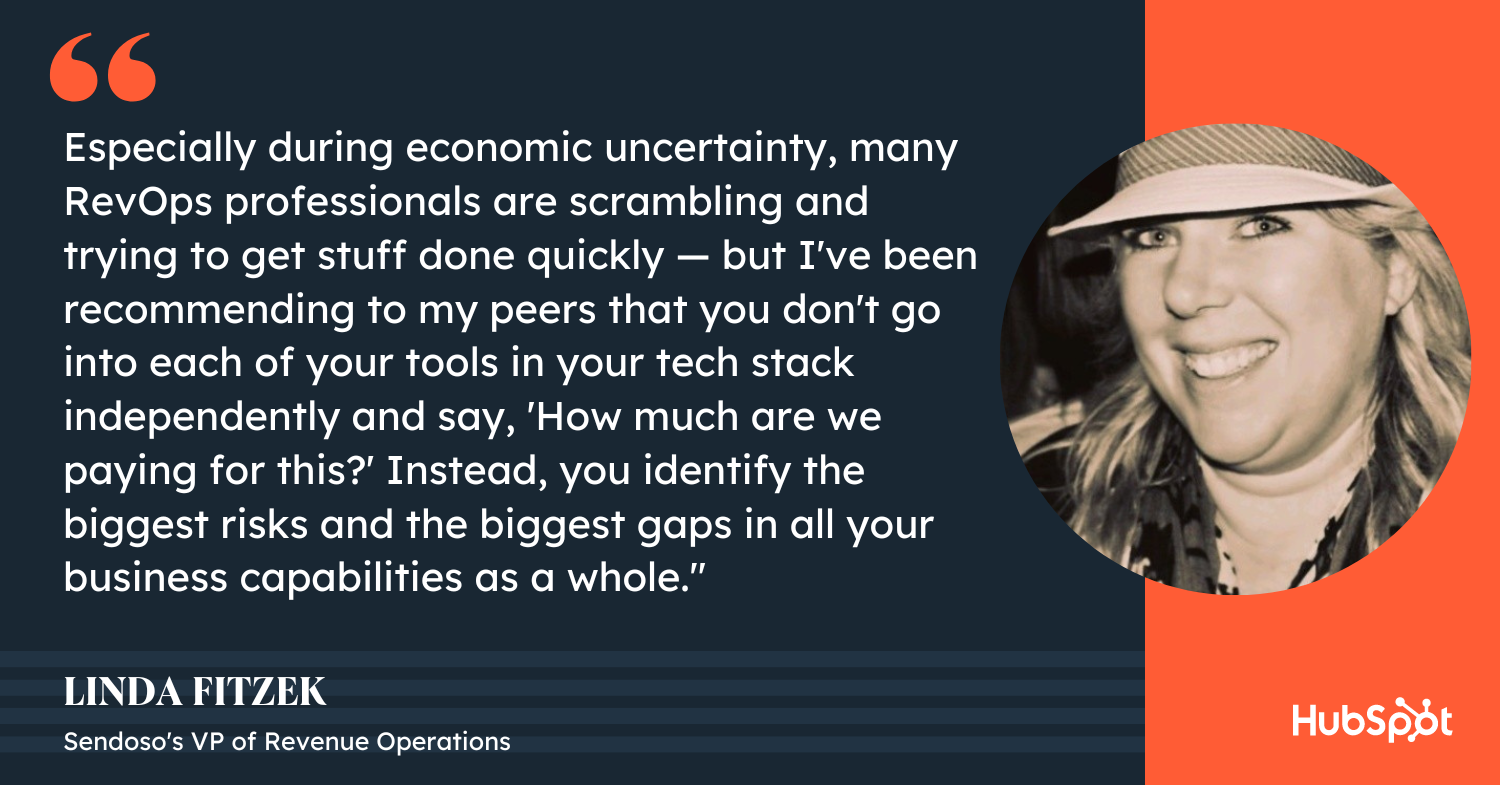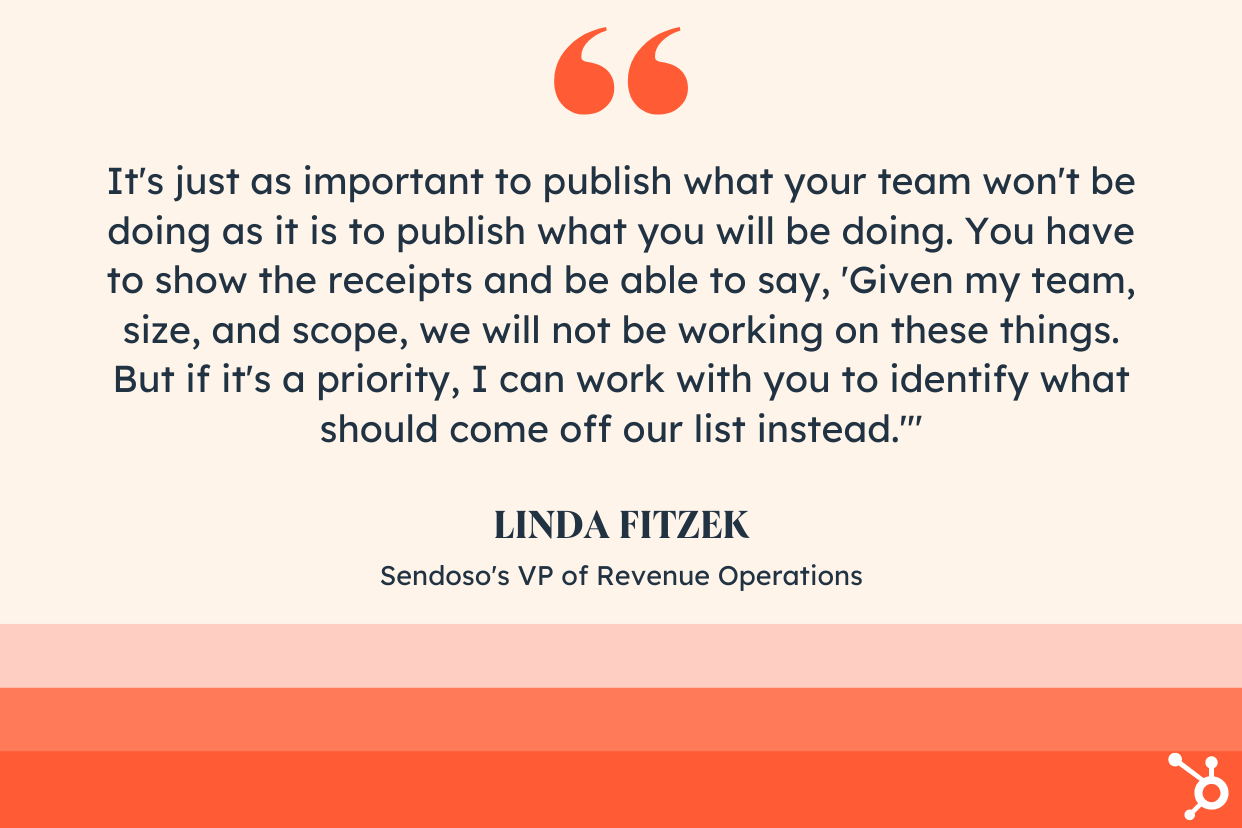As businesses continue to shift their strategies to create a more streamlined, efficient customer journey, it’s going to become vital for every business to invest time, energy, and resources into a Revenue Operations team, otherwise known as RevOps.
A RevOps team can help align your sales, marketing, and customer success departments and keep each department accountable for driving revenue growth for your business, while identifying potential areas of friction in your business at-large.
Investing in RevOps is a powerful opportunity to positively impact your company’s bottom line: In fact, B2B companies that invest in RevOps report a 10% to 20% increase in sales productivity and 30% reduction in GTM expenses.
To help your RevOps team drive growth in 2023 and beyond, I spoke with Sendoso’s VP of Revenue Operations, Linda Fitzek. Let’s dive into some of the biggest missteps she sees RevOps teams making, and how you can avoid them.
The 5 Biggest Missteps Your Revenue Operations Team Might Be Making
1. You’ve explored your tech stack independently, but you haven’t looked at all of your business capabilities as a whole.
Linda Fitzek told me that most RevOps professionals will first identify a business problem, and then explore best-in-class technologies that can solve for those problems.
But identifying individual tech solutions doesn’t enable you to look at the full picture of your business processes, so instead, she urges teams to look at all business capabilities across the go-to-market lifecycle, and then try to plug-in where there are strengths and weaknesses.
As she puts it, “Especially during economic uncertainty, many RevOps professionals are scrambling and trying to get stuff done quickly — but I’ve been recommending to my peers that you don’t go into each of your tools in your tech stack independently and say, ‘How much are we paying for this?’, ‘Whose using it?’, and ‘What are we getting out of it?’“

Instead, she advises teams to identify the biggest risks and the biggest gaps in their overall business strategy.
She adds, “And then you can say, ‘Okay, do I have the technology in my stack that can help with my biggest gaps?‘ But it’s never going to be like ‘We have a problem, let’s plug in some technology.’ Instead, we need to understand the full process. We need to have the right people in seats that are driving that capability, and the right processes and data in-place. And then we need to invest in the right technology to scale it.”
One example Fitzek gives is ZoomInfo. As she explains it, ZoomInfo can help you with building your books of business out, and identifying new contacts within your books of business. But it can also help you know your total relevant market, build up your ICP, and can make you smarter in your go-to-market processes.
“When I see software like ZoomInfo,” Fitzek told me, “or software that’s starting to help with multiple business capabilities, that’s where I start to build-up the picture of what we’re doing right, and how we’re optimizing with our vendor partners. The best software companies will be the ones that can help their customers identify those use cases and the capabilities that need to be built to meet their unique needs.”
2. You’ve underinvested in customer experience.
The second major misstep Fitzek sees RevOps teams making is underinvesting in the customer experience, or CX, side of the business.
As she told me, “It’s been really difficult to measure customer success metrics. Sendoso’s Customer Marketing Director, Leslie Barrett, has done a great job of establishing the success metrics within the realm of community marketing by quantifying the impact of community marketing and ‘SuperSenders’ (our best users) on our pipeline and revenue growth, but it’s a relatively underinvested area in comparison to the top-of-funnel lead to MQL to SQL pipeline, which became the gold standards of KPIs in the early 2000s.”
Of course, she also acknowledges that it’s human nature to lean into what you know. If you’re a RevOps professional with a marketing or sales background, for instance, it makes sense that you’ll feel most confident you can make immediate impact in those spaces. By comparison, you might not know much about customer success.
For Fitzek, she solves for this challenge by leaning into the head of CX and trying to understand what his priorities are, and then connecting the dots with the customer marketing team.
Fitzek says, “What you’re trying to do with brand-building is create a cohesive customer experience. So our customer experience and customer marketing teams need to be orchestrating together, and they need to be aware of what each other is doing.”
Identifying your own team’s weak spots or biases when it comes to areas of the business — whether it’s marketing, sales, or customer success — is vital for identifying the right people within your business who can help you fill in those gaps.
(Struggling to deliver a strong customer experience? Take a look at Sendoso’s e-book on the topic to uncover new ways to keep customers coming back.)
3. You haven’t hired strong RevOps generalists.
If you notice your RevOps team struggles the most when working with one department, such as marketing, sales, or customer service, you might conclude that you need to hire a specialist with a background in one of those industries.
But Fitzek told me she’s more interested in hiring generalists.
As she puts it, “I’ve always hired generalists, probably because I am one myself. I want somebody that’s able to solve a problem. My direct reports need to be able to understand the challenge, come up with a solution, project manage into completion, and measure its impact. That’s always been core to my strategy.”
Fitzek adds, “I spent a long time at Google, and autonomy and agility were key skills that were valued there, so being able to pivot quickly and understand business problems was critical, and I’ve brought that with me into my role at Sendoso.”
Similarly, it’s critical when hiring for your own RevOps team that you’ve identified the core skills you need on your team. A RevOps professional needs to be able to meet challenges across the business, measure revenue impact, and recognize broad themes as they listen to leaders across the organization.
4. You haven’t clearly outlined what you will not work on in a given quarter.
It can be easy to make too many promises, or feel like your RevOps team is stretched too thin by trying to meet the demands of every department within your company.
Which is why Fitzek encourages RevOps leaders to publish what you plan to accomplish in a given quarter — as well as what you won’t be doing.
She says, “It’s just as important to publish what your team won’t be doing as it is to publish what you will be doing. You want to be able to tell leadership, ‘Here are the things we’re working on this quarter’, because if you don’t publish it, people will assume you’re also working on something else. You have to show the receipts and be able to say, ‘Given my team, size, and scope, we will not be working on these things. But if it’s a priority, I can work with you to identify what should come off our list instead.’“

She advises RevOps leaders with smaller teams to balance requests against in-flight projects, team commitments, and revenue impact potential, and then learn to say ‘no’ to the projects that aren’t vital.
Ultimately, creating a strong direction for your team, and ensuring leadership is on-board, requires you as a RevOps leader to make the tough calls when it comes to areas of focus. Accepting too many requests will dilute your impact.
5. Your team hasn’t encouraged authenticity.
It’s worth noting that many RevOps professionals might be feeling a little bit de-motivated or stressed as we enter the economic uncertainty of 2023. And that’s normal, but the key to moving forward is being able to voice it.
As Fitzek encourages, “There’s the moment of truth when everybody is feeling burnt out where you can actually be your authentic self. You know you can have a frank conversation with your peers and say, ‘I don’t know how I’m going to get all of this done, but I’d appreciate your help.’“
She adds, “People want to be seen as in-control and effective, and, you know, working towards the right things. But sometimes we all just need to sit back and talk to each other and be more honest. Right now, we’re being asked to do more with less, and we’re all going through rounds of reductions and budget cuts and software consolidation … and we’re doing our best. So I think people just need to feel like they’re being nurtured by their company, too.”
Demonstrating patience, kindness, and transparency with your team is critical as your RevOps team navigates uncertain times. Creating a safe space to voice concerns will help your RevOps team facilitate a more resilient culture — which, in turn, will help you stay focused and calm as you make the difficult decisions required of RevOps professionals.
![]()



